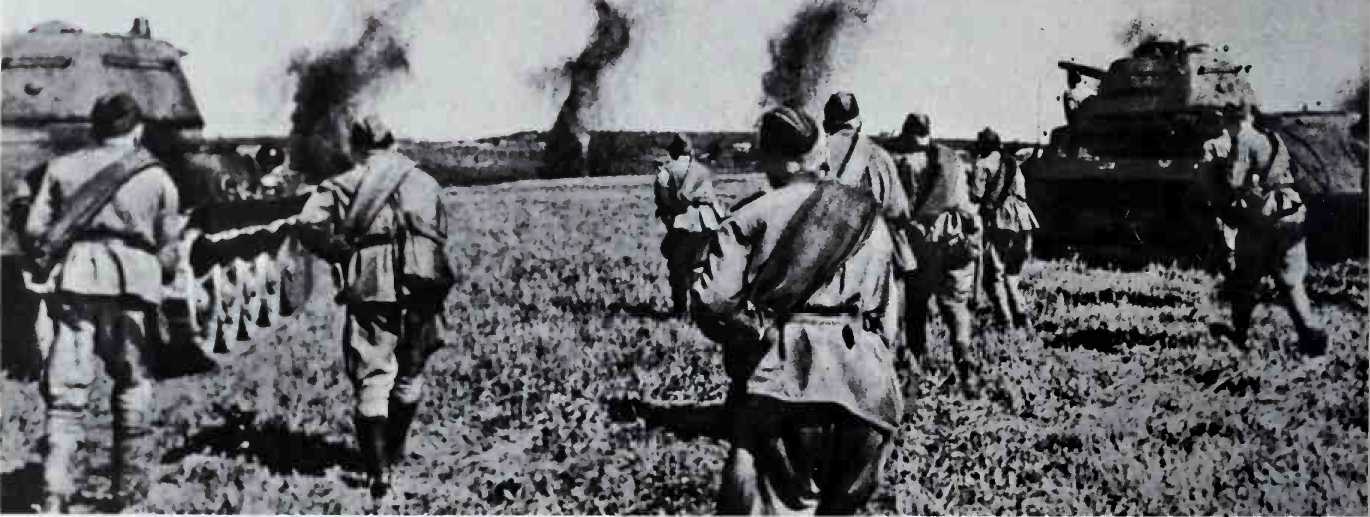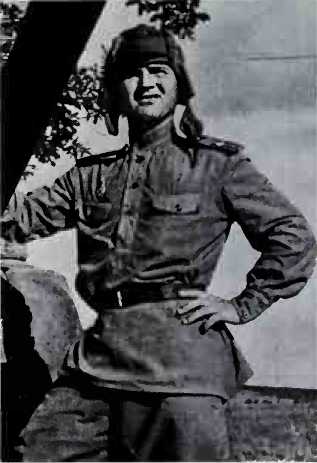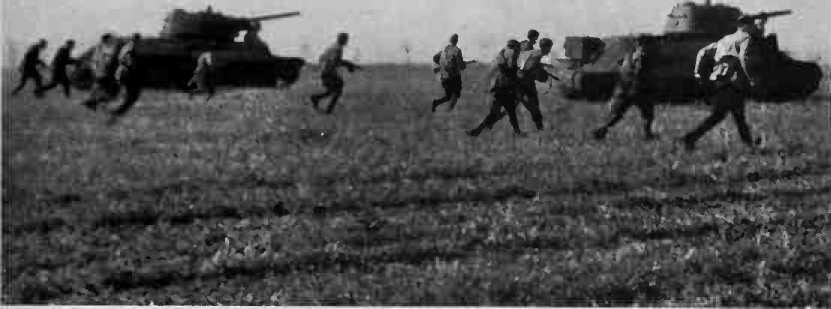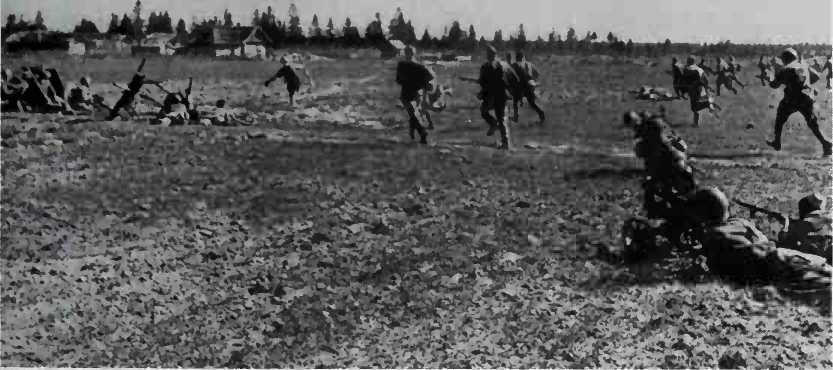According to a perfectly correct comment in the Great Patriotic War, when spring came round again, Stalin had more than sufficient means at hand to take the initiative. But confronted by the German preparations against the Kursk salient reported to him by General N. F. Vatutin, new commander of the Voronezh Front, from April 21 onwards Stalin felt, the same work assures us, that it "was more e. xpedient to oppose the enemy with a defensive system constructed in due time,
Dniepr, and Kerch’ Strait, thus liberating the eastern parts of White Russia and the Ukraine, the Donets basin, and what the Germans still held in the Kuban’.
It is true that in adopting these tactics, Stalin had the advantage of detailed information as to the strength and intentions of the adversary and that he followed the "ZifadeZZe’’preparations very closely: "Rossler,” write Accoce and Quiet, "gave them full and detailed description in his despatches. Once again, Werther, his little team inside O. K.W., had achieved a miracle. Nothing was missing. The sectors to be attacked, the men and materiel to be used, the position of the supply columns, the chain of command, the positions of reinforcements, D-day, and zero hour. There was nothing more to be desired and the Russians desired nothing more. They simply waited, confident of victory.’’
And their confidence was all the greater
<V German dispatch rider.
V The Russian counter-offensive gets under way-tanks and infantry of the Voronezh Front move south towards Belgorod.
V V One of Russia’s tank aces, Akim Lysenko. He destroyed seven German tanks in the great battle for the Kursk salient.

Echeloned in depth, and insuperable. On the basis of propositions made to it by the commanders at the front. Supreme Headquarters resolved to wear the enemy out decisively in the course of his assault, by defensive action, then to smash him by means of a counter-offensive.’’
Hence, by a curious coincidence, Stalin came round to the idea of "return attack’’ at the very time that Hitler refused to let Manstein attempt to apply it. With the Panzers smashed in the salient around Kursk, it would be a far easier task to defeat Army Groups "Centre’’ and "South’’ and attain the objectives that had been set for the end of autumn 1943: Smolensk, the Sozh, the middle and lower because first-hand information and reports from partisans confirmed the radio messages of their conscientious informer in Lucerne. Accoce and Quiet make no exaggeration. From a memo of the period it appears that in July 1943 Stalin believed he had 210 enemy divisions, excluding Finns, facing him. The official O. K.W. record for July 7 of that year gives 210 exactly, plus five regiments.
Hitler’s delays allowed the Russians to organise the battlefield on which the attack was anticipated and to do so to a depth of between 16 and 25 miles. A cunning combination of minefields was intended to channel the German armoured units onto what the Russians called "anti-

V The standard pattern of Soviet attacks-an interwoven line of infantry and tanks.

I
I
Tank fronts”, solid defence sectors particularly well provided with anti-tank guns.
The defence of the Kursk salient, which had a front of about 340 miles, was entrusted to the Central and Voronezh Fronts. The Central Front, under the command of General Rokossovsky, had five armies deployed forward, a tank army in second echelon, and two tank corps and a cavalry corps in reserve. The Voronezh Front so precise in the case of the German Army, decline to tell us the number of divisions and tanks involved in this battle; nevertheless, if we take a figure of roughly 75 infantry divisions and 3,600 tanks, this would appear to be about right. The Great Patriotic War, however, drops its reserve in speaking of the artillery. If we believe what we read, and there is no reason not to do so, Rokossovsky and Vatutin could count on no fewer than
20,000 guns, howitzers, and mortars, including 6,000 anti-tank guns, and 920 rocket launchers. For example, in order to bar the axis along which it was expected that Model’s main thrust would be developed, Rokossovsky allocated to Pukhov’s 13th Army a whole additional corps of artillery, totalling some 700 guns and mortars. The defensive potential of the Red Army thus surpassed the offensive potential of the Germans, and their complete knowledge of Field-Marshals von Kluge’s and von Man-stein’s dispositions and proposed axes of advance enabled the Russians to concentrate their artillery and armoured units so as to prevent them moving in the direction intended. In the evening of July 4 a pioneer from a Sudeten division deserted to the Russians and revealed the zero hour for Operation '’Zitadelle”.

A Dismounted Russian cavalry put in an assault on a small village. By Western standards they are not only very exposed, but have a long distance to go before they reach the enemy positions. Though the picture may be posed, it still reflects the rudimentary tactics employed by the Red Army, even late in the war.
(General Vatutin) had four armies forward, two more armies (one of them a tank army) in second echelon, and two tank and one rifle corps in reserve. The Steppe Front (Colonel-General I. S. Konev), positioned east of Kursk, constituted the Stavka reserve, and comprised five (including one tank) armies, plus one tank, one mechanised, and three cavalry corps in reserve.
Air support was provided by some 2,500 planes from the 2nd and 16th Air Armies.
Even now, Soviet historians, who are




 World History
World History









